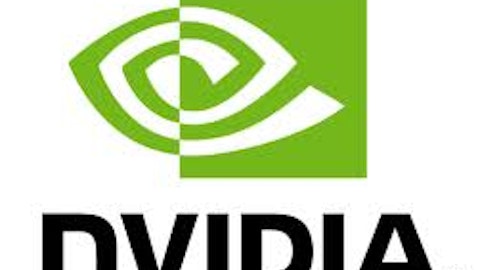If you haven’t been paying attention to Intel Corporation (NASDAQ:INTC) stock lately, you’ve missed its run. The stock that had been beaten down below $20 has risen up to almost $24 in a short time, driven by its most recent earnings results on April 16. What did the company say? ‘I’m not dead yet.’
Intel Corporation (NASDAQ:INTC) met estimates. No surprising upside. No disappointments. Many questions still remain, but Intel was able to put a floor under their stock for the time being by showing the bears that things aren’t as bad as they think. The bulls can’t throw a party yet, but at least they can get a little more comfortable. Intel Corporation (NASDAQ:INTC) showed that the stock was a steal while it had a 4%+ dividend yield and shares rose accordingly.
Looking forward, the release of the Haswell technology in Q2 is huge for Intel. The bulls and bears have been battling over Intel Corporation (NASDAQ:INTC) for quite some time. With the Haswell release, we will begin to see more clearly what the future will bring for Intel. There are lots of other levers that Intel can pull, but none are quite as big as Haswell.
Let’s look at a few key areas specific to Intel Corporation (NASDAQ:INTC) for a temperature of how the company’s doing currently before we look too far into the future.
Valuation
On the traditional valuation metrics of P/E and Price/Sales, Intel is reasonably valued at 11.9 times and 2.3 times, respectively. Unfortunately, the 11.9 P/E is at the high range of what we’ve seen from Intel over the past couple years. The Price/Sales ratio is well in-line with what you would expect from a mature, slower growth company such as Intel.
Cash flow and ROE
Intel is generating plenty of cash. Until recently, the cash flow from operations was trending higher. But, the recent trend downward is what concerns me and many other investors. We can debate all day long whether Intel’s huge CapEx spending is wise or not. Time will tell on that. But cash flow from operations doesn’t lie. It’s either coming in or going out. In Intel Corporation (NASDAQ:INTC)’s case, it’s still coming in just fine, but it needs to turn that trend higher again.
Return on Equity (ROE) is another metric that I like to follow closely because it’s difficult for a company to manipulate, especially when you look at a trend versus just one period of time. In Intel’s case, they make a very good return of over 20%. The only problem is that, again, the trend is clearly headed in the wrong direction.
Competition
Coming out of the depression of 2008-09, would you have done well buying Intel, or any of its competitors, or just sticking with the S&P 500 itself? The answer is below.
The clear winner is ARM Holdings plc (ADR) (NASDAQ:ARMH). Nothing else even comes close. Intel’s gain of 80.5% sounds great, but really not so much considering that the S&P 500 was up 94.7%.
Advanced Micro Devices, Inc. (NYSE:AMD) and NVIDIA Corporation (NASDAQ:NVDA)? Forget about it. These two chip makers really aren’t worth owning. AMD used to be a significant competitor to Intel. Now it languishes with a $2 billion market cap and scuffles along by clinging to low-margin opportunities. Its market share in desktops has collapsed and its attempt at competing directly with NVIDIA Corporation (NASDAQ:NVDA) has been a dud. NVIDIA has been more successful than Advanced Micro Devices, Inc. (NYSE:AMD) because it has been able to dominate the graphics processing market, while also getting a stronger hold on the mobile computing market with lower power usage chips. NVIDIA Corporation (NASDAQ:NVDA) has more life than Advanced Micro Devices, Inc. (NYSE:AMD), but both will need a big kick to send their stocks higher.
On the other hand, ARM Holdings plc (ADR) (NASDAQ:ARMH) has become a considerable foe to Intel. ARM capitalized on the shift to mobile technology in a significant way by making chips that could handle low-energy needs, and also be powerful enough and be made at the right price point. ARM doesn’t make the chips, but instead develops the technology for the chips. ARM Holdings plc (ADR) (NASDAQ:ARMH) likely has a bright future ahead of it and will likely be Intel’s biggest competitor in some of the markets where they overlap.
Dividend
One of the big benefits of owning Intel has been its high dividend. In fact, you can pretty well use the dividend yield to determine when to buy. The chart below shows the dividend yield and stock price over the past couple years. Any time the dividend gets above roughly 3.5%, it’s been a perfect buying opportunity.
Intel’s dividend is also very much safe. They generated $4 billion of cash from operations in Q1 2013 and paid out only $1 billion in dividends.
Bottom line
As I mentioned in the beginning, Intel has been a battleground stock for bulls and bears. The PC industry is clearly declining. The bears will point directly to that as Intel’s demise since it’s still its largest revenue driver. The bulls look to the future possibilities that could be driven by Haswell, extra production capacity, potential for an Apple Inc. (NASDAQ:AAPL) partnership, etc. All of these remain as possibilities and/or rumors.
For now, I prefer to wait until we hear more on the Haswell release and the results from the next couple quarters. The long-term story for Intel is yet to be told. Investors should wait to see how the Haswell release and the coming quarterly results play-out before piling into the stock.
The article Intel’s Not Dead Yet originally appeared on Fool.com is written by Dave Zaegel.
Copyright © 1995 – 2013 The Motley Fool, LLC. All rights reserved. The Motley Fool has a disclosure policy.







